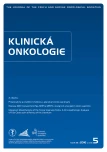Hyperthermic Isolated Limb Perfusion Combined with Tasonermin – a Perfusion Leakage Monitoring Technique
Authors:
J. Trnka 1,2; M. Špaček 3; V. Šírová 1,2; P. Mitáš 3; G. Hodková 3; J. Kubinyi 2; R. Špunda 3; J. Lindner 3
Authors‘ workplace:
Oddělení radiační ochrany, VFN v Praze
1; Ústav nukleární medicíny, 1. LF UK a VFN v Praze
2; II. chirurgická klinika kardiovaskulární chirurgie 1. LF UK a VFN v Praze
3
Published in:
Klin Onkol 2016; 29(5): 375-379
Category:
Short Communication
doi:
https://doi.org/10.14735/amko2016375
Overview
Background:
Hyperthermic isolated limb perfusion is used to treat irresectable extremity malignancies. It is based on the following principle – the perfusion of the extremity is isolated from systemic circulation and connected to an extra-corporal circuit via which a very high concentration of a chemotherapeutic agent is administered into the blood compartment of the extremity. In some cases, treatment efficiency can be improved using tasonermin (a TNF-α agent). By itself, tasonermin can cause severe health complications in patients if leakage into systemic circulation results in a level that exceeds the maximally tolerated dose. Therefore, it is important to monitor for leakage during the whole operation.
Method:
Leakage monitoring was performed by a nuclear medicine method based on the measurement of activity of a gamma-emitting radiotracer detected by a scintillation probe located over the heart. An amount of radiotracer that resulted in a basal level of measured signal was first administered into the systemic circuit followed by the administration of a second, one order of magnitude higher amount of radiotracer into the perfusion circuit. Leakage, when it occurred, increased the count rate detected over the heart, and the mathematical relation between leakage level and count rate increase was derived.
Results:
In our department, the method was tested and optimized during isolated limb perfusion without using a TNF-α agent. Then, accreditation for the use of TNF-α was granted. Since then, the method has been used to monitor leakage in all cases of isolated limb perfusion with TNF-α. All isolated limb perfusion operations with TNF-α passed without complications. The radiation burden was almost negligible for both the patient and medical staff.
Conclusion:
The method described in this report represents a reliable method for perfusion leakage monitoring when using TNF-α in our department.
Key words:
perfusion – isolated limb – TNF-α – leakage – monitoring – nuclear medicine – radiopharmaceuticals
The authors declare they have no potential confl icts of interest concerning drugs, products, or services used in the study.
The Editorial Board declares that the manuscript met the ICMJE recommendation for biomedical papers.
Submitted:
16. 6. 2016
Accepted:
21. 6. 2016
Labels
Paediatric clinical oncology Surgery Clinical oncologyArticle was published in
Clinical Oncology

2016 Issue 5
Most read in this issue
- The Impact of High Protein Nutritional Support on Clinical Outcomes and Treatment Costs of Patients with Colorectal Cancer
- Treatment of Relapsed and Refractory Hodgkin Lymphoma – Recommendations of the Czech Hodgkin Lymphoma Study Group
- Multimodal Therapy of Recurrent Malignant Schwannoma
- Malignant Mesothelioma of the Tunica Vaginalis Testis. A Clinicopathologic Analysis of Two Cases with a Review of the Literature
